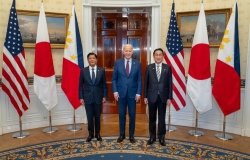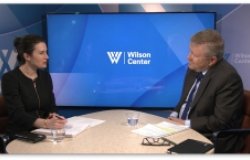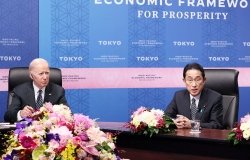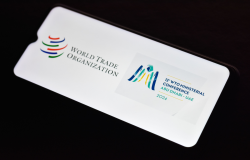Initiatives on Manufacturing and the Workforce
With Emily DeRocco, Senior Vice President of the National Association of Manufacturers (NAM) and President of The Manufacturing Institute
Overview
Here to discuss new strategies for manufacturing and innovation in the U.S. economy, in a meeting jointly sponsored by the Program on Science, Technology, America, and the Global Economy of the Woodrow Wilson Center and the Massachusetts Institute of Technology (MIT), was Emily DeRocco, Senior Vice President of the National Association of Manufacturers (NAM) and President of The Manufacturing Institute. Asserting that "we have to do everything possible" to ensure the continued health of the manufacturing industry, DeRocco presented and discussed the strategy of The Manufacturing Institute to revitalize the U.S. economy's manufacturing sector, focusing specifically on the need to develop both a well-trained and highly skilled manufacturing workforce and a national innovation network.
As background, DeRocco explained how her activities in her past post at the Department of Labor informed her present work at The Manufacturing Institute. As Assistant Secretary of Labor, DeRocco was responsible for the implementation of several successful programs, including the High Growth Job Training Initiative and the WIRED Initiative. The former sought to better coordinate the skills demanded by businesses with programs of study at educational institutions, specifically community colleges, while the WIRED Initiative attempted to strategize the development of local economies in thirty-nine selected regions by utilizing the resources, talent, and opportunities of each. She emphasized that "this in not about winners and losers – there is a future for each regional economy."
DeRocco then expanded upon the agenda of The Manufacturing Institute. First, it calls for increased research, which will critically support the manufacturing industry by filling gaps in current information and data. DeRocco has set up three strategic roundtables to discuss the needs of the industry and how to meet them.
In addition, The Manufacturing Institute is working to foster the growth of a highly skilled manufacturing workforce and a national innovation network. Several key components are necessary to attract and cultivate a talented labor force. For the manufacturing sector to be appealing, its negative image must be dispelled. Many are uninterested in the industry because they assume that U.S. manufacturing as a whole is dwindling, especially as the media constantly reports factory closings and mass layoffs. Furthermore, DeRocco explained that firms in the manufacturing sector should update their human resource practices to tailor their image to a younger population. Studies have shown that the emerging generation of workers values the ability to make a contribution in their workplace, the relationships they have with their colleagues, and job flexibility.
Equally important, DeRocco asserted the manufacturing industry should focus on expanding the diversity of its workforce, saying, "We have the opportunity to leave no worker behind." She cited a recent poll among manufacturing firms in which eighty percent of the respondents reported that they had difficulty finding the high-skilled workers that they needed. This lack could translate into new opportunities for women, immigrants, transitioning workers, and at-risk youth. However, the industry has to take steps to eliminate barriers these populations face in entering the workforce. For example, in the case of immigrants, DeRocco suggested that firms implement language training programs such as sed de saber.
In addition, she advocated for the creation of an applied STEM high school diploma that would prepare students to enter high skills jobs in addition to college. She argued that providing such an alternative pathway in high school may appeal to students who might have otherwise dropped out of high school and that such a program would help to remove the stigma of vocational education in the United States, as it would lead students to high-paying middle class jobs in manufacturing. Finally, she suggested the development of a manufacturing certification program for secondary schools and two-year and four-year colleges. Such a program would serve two purposes: it would ensure that schools are teaching students skills that can transfer into the workplace and it would also measure the quality of different educational programs.
Lastly, DeRocco spoke about the creation of a national innovation network to encourage the exchange of information in the manufacturing industry. Firms that produce the same goods and are located near one another, or "clusters," should devise a vehicle through which firms can discuss and share information about their productivity barriers. She proposed similar information-sharing programs for entrepreneurs who start small manufacturing businesses, as small firms accounted for sixty-five percent of job growth in recent times. In addition, the manufacturing sector could better harness the vast resources of government programs like the WIRED initiative. If the government was more transparent about their available enterprise assistance and support, and provided better services for technology diffusion and access to global markets, the innovation network would be even more effective.
In sum, DeRocco pushed for better support of the manufacturing industry, especially with recognition of its importance as "the bedrock of the American Economy."
Drafted by Nick Mills, STAGE Program
Thank you for your interest in this event. Please send any feedback or questions to our Events staff.










